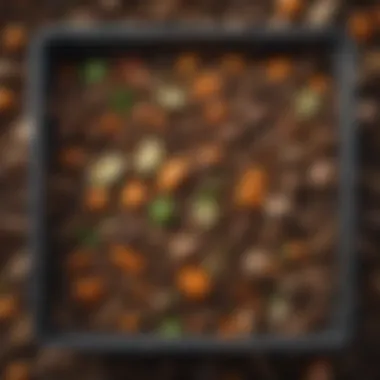Unlocking the Secrets of Compost Bins: A Green Solution for Waste Management


Overview of Compost Bins: A Sustainable Waste Management Solution
Composting is a vital practice in waste management, central to promoting environmental sustainability 🌱. It involves the decomposition of organic matter to create nutrient-rich compost, reducing waste sent to landfills while enriching soil. Compost bins play a pivotal role in this process, offering a practical and eco-friendly way for individuals to contribute to a greener planet. Understanding the fundamentals of composting and the benefits it brings is essential for anyone looking to minimize their ecological footprint.
Significance of Compost Bins
Compost bins serve as a simple yet powerful tool in the realm of waste management and sustainability. By diverting organic waste from landfills, they help mitigate greenhouse gas emissions and reduce the strain on limited landfill space 🏞️. Additionally, composting enriches soil health, promoting plant growth, water retention, and biodiversity in ecosystems. The significance of compost bins lies in their ability to transform waste into a valuable resource, promoting a circular economy mindset among individuals and communities.
Current Challenges in Composting
While composting offers numerous benefits, several challenges hinder its widespread adoption and effectiveness. One significant issue is the improper disposal of organic waste, leading to contamination and odor problems in compost piles. Inadequate knowledge about composting techniques and lack of access to suitable bins are additional barriers faced by individuals interested in composting. Overcoming these challenges requires education, infrastructure support, and community engagement to foster a culture of responsible waste management.
Sustainable Best Practices
Embracing sustainable composting practices is key to maximizing the environmental benefits of compost bins. Proper segregation of organic waste, balancing carbon and nitrogen ratios, and aerating the compost pile are essential steps for successful composting. Utilizing a mix of green and brown materials, such as kitchen scraps, yard waste, and shredded paper, fosters faster decomposition and nutrient-rich compost production. By following these best practices, individuals can create high-quality compost while minimizing environmental impact.
Impact on Ecosystems and Communities
The impact of composting extends beyond waste reduction, influencing ecosystems, communities, and future generations. By diverting organic waste from landfills, composting reduces methane emissions and contributes to climate change mitigation. Healthy soil resulting from compost application enhances plant growth, reduces erosion, and promotes biodiversity in local habitats 🌿. Community composting initiatives foster social cohesion, environmental awareness, and sustainable practices, creating a ripple effect of positive change in society.
Importance of Conservation and Sustainability
Conserving natural resources and adopting sustainable practices are imperative for mitigating environmental degradation and preserving Earth's natural heritage. Compost bins epitomize the importance of conservation efforts by turning waste into a valuable resource, closing the loop on resource consumption. By recognizing the significance of composting in waste management and sustainability, individuals can take meaningful steps towards a greener future for generations to come.
Introduction to Compost Bins
Compost bins play a crucial role in the realm of waste management and environmental sustainability. As we navigate the challenges of increasing waste production and diminishing resources, understanding the essence of composting becomes paramount. Composting is not merely a method for reducing kitchen scraps or yard waste; it is a sustainable practice that transforms organic material into nutrient-rich soil additives. This process significantly contributes to reducing landfill waste and greenhouse gas emissions, embodying the core principles of the circular economy.
What is Composting?
Composting is a natural biological process that decomposes organic matter, such as food scraps, yard trimmings, and paper products, into a valuable soil amendment. This decomposition process is facilitated by microorganisms like bacteria, fungi, and insects, breaking down the materials into simpler organic compounds. By composting, we mimic nature's recycling process, returning nutrients back to the soil and reducing our ecological footprint in the process.
Benefits of Composting
The benefits of composting extend far beyond creating a rich soil amendment. Composting helps enrich soil fertility, improving plant growth and resilience. Furthermore, composting aids in retaining moisture in the soil, reducing the need for synthetic fertilizers and promoting soil conservation. From mitigating climate change by sequestering carbon to minimizing the reliance on chemical inputs, composting embodies a holistic approach to sustainable agriculture and waste management.


Importance of Compost Bins
Compost bins serve as the cornerstone of a successful composting system. These bins provide a controlled environment for organic materials to decompose efficiently, regulating oxygen levels, moisture content, and temperature. By containing the composting process within a bin, we can control potential odors, pests, and leachate, ensuring a hygienic and effective waste management solution. Whether in a backyard setting or a community garden, compost bins offer a practical and accessible means to adopt eco-friendly practices and contribute to a more sustainable future.
Types of Compost Bins
Compost bins come in various types, each offering unique advantages and considerations in the realm of sustainable waste management. Understanding these different types is crucial in selecting the most suitable option for your composting needs. By delving into the specifics of bin composting, tumbler composting, and worm composting, individuals can make informed decisions that align with their environmental goals.
1. Bin Composting
Bin composting involves the use of enclosed containers to contain organic materials and facilitate the decomposition process. This method is popular due to its simplicity and versatility, making it accessible to both beginners and experienced composters alike. The key benefits of bin composting include ease of maintenance, odor control, and protection from pests. However, it is essential to monitor the moisture levels and turn the materials regularly to ensure proper aeration and decomposition. By following these guidelines, individuals can harness the power of bin composting to generate nutrient-rich soil amendments for their gardens.
2. Tumbler Composting
Tumbler composting introduces a dynamic approach to composting by utilizing rotating drums or bins to expedite the breakdown of organic matter. This method offers the advantage of increased aeration and faster decomposition rates compared to traditional bin composting. Tumbler composters allow for easy mixing of materials, resulting in a more homogenous compost mixture. While tumbler composting requires less manual labor and provides quicker results, users should pay attention to balancing the carbon-to-nitrogen ratio and maintaining optimal moisture levels. By embracing tumbler composting techniques, individuals can elevate their composting practices and enhance the sustainability of their waste management efforts.
3. Worm Composting
Worm composting, also known as vermicomposting, incorporates the use of worms to break down organic materials into nutrient-rich castings. This method relies on the natural enzymatic activity of worms to accelerate the composting process. Worm composting is particularly suitable for individuals with limited space or those seeking to compost indoors. The benefits of worm composting include efficient waste reduction, minimal odor, and the production of high-quality vermicompost. To ensure the success of worm composting, it is crucial to maintain proper bedding materials, provide adequate moisture, and manage the worm population effectively. By implementing worm composting techniques, individuals can harness the biological power of worms to convert kitchen scraps into valuable soil amendments.
Setting Up a Compost Bin
Setting up a compost bin is a crucial step in promoting sustainability and waste management in the context of this comprehensive guide to compost bins. The process of establishing a compost bin entails several key elements that are essential for its success. By selecting an appropriate location, gathering all the necessary components, layering materials correctly, and monitoring the moisture levels, individuals can kickstart their journey towards effective composting.
Choosing the Right Location
Selecting the ideal location for your compost bin is a critical decision that can impact its overall functionality. The chosen spot should receive adequate sunlight and be easily accessible for regular maintenance activities. Additionally, it is vital to place the bin on a level surface to prevent any potential imbalance or structural issues over time.
Essential Components for Composting
To ensure the efficient breakdown of organic matter, it is essential to include the right components in your compost bin. These components generally consist of a balanced mix of green (nitrogen-rich) and brown (carbon-rich) materials, which help facilitate the composting process. Common examples include fruit and vegetable scraps, leaves, grass clippings, and shredded paper.
Layering Materials Correctly
Properly layering the materials in your compost bin is crucial for promoting aeration and optimizing the decomposition process. By alternating between green and brown materials in thin layers, you create an ideal environment for beneficial microorganisms to thrive. This layering technique fosters nutrient recycling and ensures a well-balanced compost mixture.


Maintaining Proper Moisture Levels
Maintaining adequate moisture levels within the compost bin is imperative for sustaining microbial activity and promoting decomposition. While it's essential to keep the materials moist, excessive water can lead to anaerobic conditions and unpleasant odors. Regularly monitoring and adjusting the moisture content by adding water or dry materials is key to achieving a healthy composting environment.
Composting Dos and Don'ts
Composting dos and don'ts play a pivotal role in ensuring the success and efficiency of your composting journey. By adhering to a set of dos and avoiding the don'ts, you can accelerate the decomposition process, minimize unpleasant odors, and generate nutrient-rich compost for your garden. Understanding the dos and don'ts is essential for maintaining a healthy compost bin ecosystem.
Dos of Composting
When it comes to composting, there are several key dos that can elevate your composting game. Firstly, ensure a proper balance of green and brown materials. Green materials include nitrogen-rich items such as vegetable scraps and grass clippings, while brown materials consist of carbon-rich components like dry leaves and cardboard. Balancing these inputs is crucial for optimal decomposition.
Secondly, remember to turn your compost regularly. This aids in aerating the pile, promoting the growth of beneficial microorganisms, and accelerating the breakdown process. Additionally, maintaining the right moisture levels is vital. Aim for a damp sponge-like consistency to facilitate decomposition without causing waterlogging.
Furthermore, adding a compost starter or activator can supercharge the decomposition process by introducing a variety of microorganisms that aid in breaking down organic matter. Lastly, be patient and consistent. Composting is a natural process that takes time, so regularity in adding materials and monitoring the compost pile is key to successful composting.
Don'ts of Composting
Equally important are the don'ts of composting, which can hinder the quality and effectiveness of your compost. Firstly, avoid adding meat, dairy, or oily foods to your compost bin. These items attract pests, slow down decomposition, and can lead to unpleasant odors. Additionally, steer clear of pet droppings, as they may contain pathogens that can survive the composting process.
Another critical don't is refraining from adding diseased plant material to your compost. Diseases can persist in the compost and spread to your garden when you use the finished product. Likewise, avoid putting weeds with mature seeds into the bin, as they might germinate and cause weed issues in your garden later on.
Lastly, do not neglect the balance of your compost pile. An imbalance of green and brown materials can result in a slow or incomplete decomposition process. By steering clear of these don'ts and embracing the dos of composting, you can cultivate a thriving compost bin that yields nutrient-dense compost for your gardening endeavors.
Troubleshooting Compost Bin Issues
In the domain of composting, troubleshooting is a vital aspect that ensures the smooth functioning of your compost bin. By addressing issues promptly, you can maintain an efficient composting process while avoiding setbacks that may hinder the decomposition of organic matter. Troubleshooting compost bin issues is essential for sustaining a healthy compost environment, promoting the breakdown of materials, and preventing nuisances like pests, odors, or improper moisture levels. This section will delve into key strategies and practical solutions to overcome common challenges that may arise during composting.
Dealing with Pests
When encountering pests in a compost bin, it's crucial to act swiftly to safeguard the integrity of your compost. Common pests like fruit flies, ants, or rodents can disrupt the composting process and spread diseases. To tackle pest infestations, consider using natural remedies like introducing beneficial nematodes or diatomaceous earth, which are eco-friendly and safe for the environment. Additionally, ensure your compost pile has a balanced carbon-nitrogen ratio to deter pests, and avoid adding dairy, meat, or oily foods that attract unwanted critters.
Addressing Odor Problems
Unpleasant odors emanating from your compost bin can indicate imbalances in the decomposition process. To address odor issues effectively, aerate the compost pile regularly to enhance airflow and promote aerobic decomposition. Mixing in dry carbon-rich materials like leaves or sawdust can help absorb excess moisture and reduce foul smells. Moreover, refrain from composting meat, fish, or dairy products, as they contribute to putrid odors and attract pests. Implementing proper layering techniques and turning the compost regularly can mitigate odor problems and foster a healthier composting environment.


Fixing Compost that's Too Wet or Too Dry
Maintaining the ideal moisture level is pivotal for successful composting. Compost that is too wet tends to become anaerobic, producing a foul smell and slowing decomposition. On the other hand, overly dry compost hinders microbial activity and delays the breakdown of materials. To remedy excessively wet compost, incorporate dry browns like straw or shredded paper and increase aeration by turning the pile more frequently. In contrast, dry compost can be revitalized by adding water gradually and mixing the pile to distribute moisture evenly. Monitoring moisture levels regularly and adjusting environmental conditions accordingly will ensure optimal composting outcomes.
Harvesting and Using Compost
In the realm of sustainable waste management, the section on harvesting and utilizing compost plays a pivotal role in this extensive guide. Harvesting and Using Compost are crucial aspects that ensure the effectiveness of composting efforts and contribute to environmental sustainability. By understanding the signs of ready-to-use compost, applying it in garden practices, and efficiently storing excess compost, individuals can maximize the benefits of their compost bins while reducing waste.
Signs of Ready-to-Use Compost
Identifying signs that compost is ready for use is a key component of successful composting. Ready-to-use compost should have a dark, crumbly texture with an earthy smell, indicating that the organic materials have decomposed adequately. Additionally, the compost should be free of any visible food scraps or other recognizable materials. These signs signify that the compost is nutrient-rich and suitable for application in gardens or landscaping projects.
Applying Compost in Your Garden
Applying compost in gardens is a sustainable practice that enriches the soil and promotes plant growth. When using compost in the garden, it is essential to spread a layer of compost over the soil surface and gently incorporate it into the top few inches of soil. This helps improve soil structure, water retention, and nutrient levels, creating a healthy environment for plants to thrive. Additionally, incorporating compost reduces the need for chemical fertilizers, leading to a more eco-friendly and cost-effective gardening approach.
Storing Excess Compost
Efficiently storing excess compost is paramount to prevent waste and ensure a sustainable composting process. Utilizing a designated compost storage area or bin can help preserve the quality of excess compost for future use. It is important to store compost in a cool, dry place to prevent odors and nutrient loss. By covering the compost to protect it from excessive moisture or sunlight, individuals can prolong the shelf life of excess compost and have a readily available supply for future gardening or landscaping projects.
Wrapping Up: Sustainable Practices
In the final section of this in-depth guide to compost bins, we delve into sustainable practices, emphasizing their crucial role in environmental conservation and waste management. The aspect of sustainable practices encapsulates the essence of this article, underlining the long-term impact and benefits of composting as a sustainable approach to waste management.
Sustainable practices in composting extend beyond just recycling organic waste; they foster a deep-rooted connection between individuals and the environment. By adopting sustainable practices like composting, individuals contribute to reducing landfill waste, minimizing greenhouse gas emissions, and enriching the soil health in return.
Embracing sustainable practices highlighted throughout this guide not only aids in waste reduction but also fosters a sense of responsibility towards the planet. It encourages a shift towards mindful consumption habits, promoting a circular economy where resources are utilized efficiently and effectively.
For a eco-friendly lifestyle, initiating sustainable practices such as composting is a foundational step towards a greener future. It sets the stage for a more harmonious relationship between humans and nature, aligning with the principles of ecological balance and preservation for future generations to come.
Continuing Your Eco-Friendly Journey
As we conclude our exploration of compost bins and sustainable practices, it is imperative to discuss continuing your eco-friendly journey. This subsection serves as a bridge, connecting readers with actionable steps to sustain and expand their engagement with eco-friendly practices beyond composting.
Continuing your eco-friendly journey involves integrating sustainability into all aspects of life. From reducing single-use plastic consumption to supporting local farmers markets, each choice has the potential to make a positive impact on the environment and society as a whole.
Educating oneself on current environmental challenges and exploring innovative eco-friendly solutions is paramount to fostering a sustainable mindset. By staying informed and actively participating in sustainable initiatives, individuals can significantly contribute to a healthier planet and a brighter future.
Moreover, spreading awareness and inspiring others to join the sustainability movement amplifies the collective impact. Empowering communities to embrace eco-friendly practices creates a positive ripple effect, driving towards a more sustainable and resilient world.
In essence, continuing your eco-friendly journey is not just a personal commitment; it is a collective responsibility towards safeguarding our planet for present and future generations. By making conscious choices and advocating for sustainable practices, each individual becomes a catalyst for positive environmental change.



